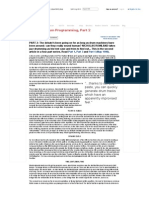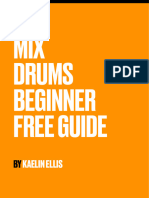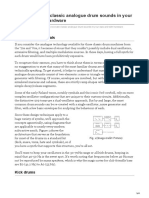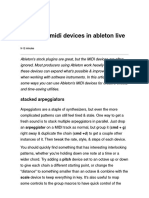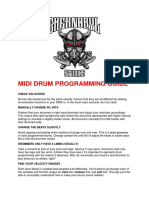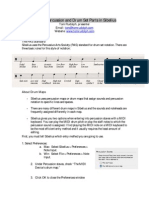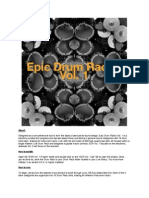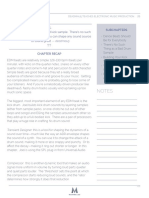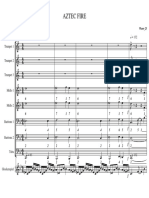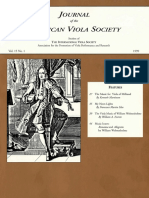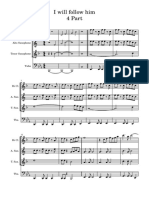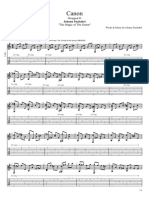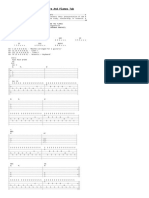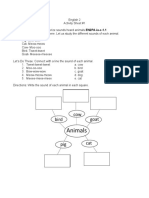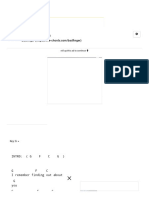LOG IN REGISTER SUBSCRIBE SHOP HELP 0 items Search
SOUND ON SOUND
NEWS FORUM MAGAZINE REVIEWS TECHNIQUES PEOPLE SOUND ADVICE MUSIC BUSINESS
HOME > TECHNIQUES >
E!ective Drum Programming: Part 4
Tips & Techniques
Drum Machines
By Nicholas Rowland Published May 1998
Zoom's 1201, Sherman's Filter Bank and the North Pole resonant filter plug-in for Cubase VST (Mac) all o!er
valuable treatments for the grunge merchant on the prowl.
In this article...
Even a killer rhythm pattern won't make the grade if it's played with Introduction
lacklustre sounds. In the concluding part of this series, Nicholas Rowland Take It To The Limit
puts on his sound designer's head and explains how you can re-tread your Pan Handling
tired timbres... MIDI Methods
Set Phasers To Stun
In the first instalment of this series, I made the point that one of the main attractions of Grunge Hill
sampled rhythm loops is often not the intricacies of the rhythm pattern itself, but the sonic Sampled Delights
character of the loop. This character might come from the particular ambience of the recording And Finally...
or the accidental presence of other instruments which add an unexpected twist to the drum Breaking The Stereo Barrier
rhythm. Or it might be there because someone has employed a whole bank of e!ects to flog In Through The Outboard
the sounds to within an inch of their lives.
In this Series
We've already looked at more extreme approaches to rhythm programming, in last month's
issue. But in this final session of tub-thumping I'd like to talk about a number of techniques for E!ective Drum Programming: Part 1
manipulating drum and percussion sounds — techniques which can be used to make even the E!ective Drum Programming: Part 2
most boggish of bog-standard drum machine rhythms sound that bit more interesting. E!ective Drum Programming: Part 3
E!ective Drum Programming: Part 4
But first a disclaimer. What I'm outlining here is my personal armoury of techniques: I'm not
claiming to cover the whole spectrum of possibilities. And remember — parameter values can SOS Competitions
go down as well as up.
Win! TANTRUM AUDIO Angry System
Win! UNIVERSAL AUDIO Apollo x4 Gen 2 &
Take It To The Limit Sphere DLX
The first place to look for inspiration is in the manual. In other words, it's always good to know
what your equipment is actually capable of (missus). Many drum machines and sound modules
have various on-board facilities for customising sounds, such as programmable pitch, decay,
and timbre. Some also give you control over such parameters as sample start point,
velocity-controlled pitch-bend and velocity-sensitive crossfades between samples.
https://www.soundonsound.com/techniques/effective-drum-programming-part-4 28/06/25, 19 42
Página 1 de 6
:
� Readers' Ads
VIEW ALL ADS CREATE FREE AD
On the same subject
2025 SOS Awards: THE RESULTS
February 2025
Ableton Move
Processors like the Sherman Filterbank can be employed to great e!ect when mangling your drum patterns. November 2024
Hardware Drum Machines
These parameters can be used in both subtle and not-so-subtle ways. As a simple example, you November 2024
can add interest to a straightforward rock-style rhythm pattern by using di!erent pitches of the Elektron Digitakt II
same snare drum on di!erent beats. Or try shortening the decay values on each successive November 2024
beat of a snare fill, so that the sound tightens up as it reaches the climax of the roll. Drum Beat Construction - Part 2 | SOS Podcast
June 2024
Some drum machines allow you to spread a percussion sound across the drum pads so you
can easily play it at di!erent pitches. Rather than just tapping in a straight 8th- or 16th-note From the same manufacturer
hi-hat pattern, with the voice at the same pitch, try programming in your hi-hat or other
Sherman Filterbank 2 Compact
top-line percussion instruments (such as shaker, tambourine and so on) more as melodic ri!s.
August 2019
(As an aside on tuning voices like conga and bongos, don't try and tune them to some precise
Rodec Sherman Restyler
melodic pitch — somehow this has the e!ect of making them disappear from the mix.) March 2010
SHER DELIGHT
I mentioned last month that extreme tunings of sounds can yield some unexpected results.
July 2001
Yamaha's RX5 drum machine, for example — a veritable giant of its time — allowed
Sherman Filterbank
transposition of samples over a staggering eight or nine octaves. You quickly discovered that at April 1997
very low pitches electro-toms sounded like small explosions, while splash cymbals turned into J
Arthur Rank-style gongs. Sadly, the designers of many other drum machines which o!er
tunable drum sounds see fit to restrict the pitch ranges to 'realistic' values — a pity, really, as I SIGN UP TO
don't feel you really get to know the true gut-wrenching potential of a vibraslap until you've SOS NEWSLETTERS
heard it at subsonic levels.
Pan Handling
Conventional wisdom dictates that when you place a drum sound in the stereo spectrum you
should take your lead from how it would sound if you were standing in front of a drum kit. In
other words, bass and snare dead central, hi-hat panned slightly to the right, ride cymbal
slightly to the left, and the toms spreading from half-right to half-left in descending order of
pitch. (Unless, of course, your drummer happens to be left-handed, in which case the kit
placement would be reversed.)
These rules are all there to be broken, of course, though I would stress that panning e!ects are
best applied only to sounds in the mid- to high-frequency range. As you probably know, it's
much harder for the human ear to accurately pinpoint the directional presence of
low-frequency sounds such as bass drums. Generally, then, gratuitous panning of bass sounds
is a waste of time.
Latest SOS Videos
Where a rhythm has fairly busy high-frequency percussion elements (that is, hi-hats, ride
cymbals, shakers and the like) try panning these elements hard left and right. This immediately
opens up the soundstage and helps it to feel less cluttered. Extreme pannings of tom sounds
can also work quite well in what, for want of a better phrase, we'll call 'jungle rhythms' (or, if
you want the Politically Correct term, try 'tom-intensive ethnically orientated beats').
If you want to add a new twist to the machine-gun snare-drum rolls which usually come as
standard issue with dance tracks, first program two rolls using separate snare sounds. Then
either cross-pan them during the roll; start them at opposite ends of the stereo spectrum, then
bring them together; or start them together and widen them out. Couple this with volume
Mixing Dune: Part Two OST | Alan Meyerson Webinar
fades or changes in pitch to add extra "gosh" factor.
MIDI Methods
The above ideas are easy to apply if you're using a MIDI sequencer to control drum sounds
https://www.soundonsound.com/techniques/effective-drum-programming-part-4 28/06/25, 19 42
Página 2 de 6
:
� from an external unit. With a fistful of MIDI Controller commands you can simulate ping-pong
echoes, tempo delays and dub-style delay e!ects. (In fact, sequencers such as Cubase o!er a
MIDI delay program as part of the furniture.) Regard these features as your friends.
You can also create simple echo e!ects by copying a drum pattern to another sequencer track,
then moving it forward by, say, a 16th note. You could then try assigning a di!erent style of
drum kit to this second rhythm pattern. If you were using a big-sounding rock kit for the main
rhythm, you could try a softer jazz kit played at lower volume for the 'echo'. Obviously, you can
take this technique a few steps further. For example, you could have a series of echo tracks
built around just one element of the rhythm, with each 'repeat pattern' assigned to a di!erent Trinnov NOVA User Report - PresentDayProduction
set of drum sounds.
Set Phasers To Stun
If you're triggering a drum machine or sound module from a sequencer, you'll probably have
noticed how doubling up the pattern (ie. sending the same information down the same MIDI
channel twice) causes the double-triggering of the sounds to create a kind of phasing e!ect.
This can be quite useful for giving flappy drum machine sounds a much harder edge. Try
trebling or quadrupling up and see what happens.
The phasing ploy can be used to accent individual sounds, and is e!ective when creating big, The Secrets Of Pink Floyd’s Quadraphonic PA
bad bass drum sounds. If you want to go further down this road, try programming two bass
drum samples on the same beat, but pitch one of them up by two or three octaves.
Grunge Hill
As a spin-o! from the interest in analogue synths, there has been a revival of interest in the use
of lo-fidelity techniques to give rhythm loops more roughage than a bucketful of All Bran. If this
is the kind of territory you're interested in exploring, there's plenty you can do to dirty up your
dance drums.
The basic advice here is to connect your drum machine through anything you think might
distort the sound in some way — guitar pedals, the filter section of an analogue synth with an
external input... even a miked-up bowl of custard if you feel it'll create something
interesting.E!ects treatments are an obvious place to start. Even budget units now o!er
various sound-crunching lo-fi presets. The Zoom 1201, for example — at a mere £99 — o!ers a
number of 'lo-fi' settings, plus a vocoder. E!ects plug-ins for programs such as Cubase VST are
another useful tool for the grunge merchant on the prowl. Steinberg's Grungelizer and, more
recently, the Trancemitter plug-in are worth a look, while the BIAS SFX Machine gives you a
range of e!ects from radio tuning drift to ring modulation. One piece of freeware I've recently
come across is Stephan Sprenger's North Pole resonant filter plug-in for Cubase VST (for Mac
users only at this stage). Go to www.prosoniq.com/sms/sprenger.html for details of how to
download.
There's also a range of external filters to suit
every price and pocket, including the Mutator,
the Sherman Filter Bank, the Waldorf X-Pole,
the FAT Resinator and the wonderfully named
Lovetone Meatball. Guitar pedals are also a
particularly good source of mangle-isation. Not
only are they comparatively cheap, you also get
the added bonus of gratuitous hum, noise and
distortion, particularly if you overdrive the
inputs.
For the grunge programmer on a budget, there
are a number of DIY options — all part of
general home recording tricks of yesteryear. For your own 'played down the telephone' e!ect,
try running your mix through a low-pass filter set at around 3kHz with a little bit of resonance.
Combine this with some sampled vinyl surface noise trimmed to the length of the drum pattern
and triggered alongside. You can also try recording your drum machine through a miked-up
guitar amp, preferably one with a dodgy spring reverb that's been dropped several times down
a flight of concrete steps. Or record your rhythms to tape, then play them back on a portable
cassette player turned up loud. Stick a microphone in front and enjoy.
Sampled Delights
Samplers provide another creative behaviour-modification tool. For a quick-fix lo-fi e!ect, try
sampling your drum machine pattern at a low resolution and then trigger it from your
sequencer as you would a loop from a sample CD.
If you know your sampling maths, you'll be aware that when you play a sample an octave
higher than its original pitch, the sample is in fact running at twice the speed. And conversely, if
you play it an octave lower it runs at half the original speech. So try sampling (at low resolution)
a beat-box rhythm at twice the tempo you need it, then play it an octave lower than the sample
key it was assigned to. The result is a detuned version of the rhythm running at the correct
https://www.soundonsound.com/techniques/effective-drum-programming-part-4 28/06/25, 19 42
Página 3 de 6
:
� tempo. Obviously, you can play around with the tempos and sample playback speeds to arrive
at di!erent combinations of these tempo/detuning parameters. If anyone has a mathematical
formula for determining the precise results of this approach, I'd be glad to hear it.
Try sampling (at low resolution) a beat-box rhythm at twice the tempo you need it,
then play it an octave lower...
When sampling your own loops, it's a good idea to always apply some kind of e!ect during the
sample recording process — reverb, chorus, flange, distortion, EQ, filter. Basically, what we're
interested in is messing up the frequency content a little, to try and blur the edges of the
original drum voice. Once you start pitching the rhythms up or down, the results will be that
much more interesting.
Clearly, you can apply this basic technique to entire rhythms or just sections of them. For
example, you could investigate the potential of sampling the hi-hat and top line of percussion,
then running that as a detuned rhythm loop against a bass and snare pattern provided by your
drum machine/sound expander.
Another technique related to the one above can be used to produce ethnic-sounding, lo-fi
percussion tracks. Again, this trick is based on the fact that samples played an octave higher
run at twice the usual speed. Let's say you sample a rhythm loop on middle C. Now play it back
using the G below and the G above. This works particularly well with patterns made up of latin
and hand-held percussion — bongos, congas, shakers and so on. You usually end up with a
plicky-placky percussive line at the top and a heavy-sounding tom tom-style beat running
underneath.
And Finally...
If you want to add a touch of real-life ambience to your rhythm tracks, as well as bringing in all
that touchy-feely human stu! I was banging on about in Part 2 of this series, why not record
part of your rhythms live, using real instruments?
While I recognise that most people don't have the luxury of a full drum kit to call on — or,
indeed, the kind of neighbours who would tolerate the noise — it's relatively simple to add
percussion parts to bass/snare rhythms with tambourines, shakers, maracas and other
instruments. You might even consider vocalising these sounds. Providing you're not the sort of
person who feels self-conscious going "tss-te-te-tss-te" or "che-che-che-che" into a microphone,
you might find you actually enjoy it. In one memorable (and, I have to admit, drunken) session,
a friend and I once partnered a drum machine pattern with the sound of cutlery being shaken
in a tambourine and recorded through a guitar pedal flanger. But we've both had treatment for
it now.
Clearly we're beginning to stray into territory normally inhabited by fresh-faced Blue Peter
presenters, but just before we fall into the abyss, I might as well encourage you to raid the
kitchen for pots, pans, glass jars and bags of rice, with which to construct makeshift rhythm
instruments. Just make sure an adult is present whenever you attempt to use the scissors.
And there you have it. Go forth and make beauteous beats. I'm o! to watch that old Blue Peter
episode where John Noakes makes a drum machine dust-cover out of squeezy
washing-up-liquid bottles and a length of sticky-backed plastic.
Breaking The Stereo Barrier
Many drum machines and sound modules are equipped only with a pair of stereo outs.
Yet conventional rhythm track recording wisdom dictates that bass drums are recorded
dry and snares have gated reverb applied, while hi-hats and other top-line percussion
benefits from a touch of ambient reverb.
If you can't multitrack the various elements of the rhythm separately to tape, sample the
hi-hat parts with the necessary EQ and e!ects and run this loop alongside the bass and
snare part, as supplied by the drum machine. Panning the snare and bass to opposite
sides of the stereo spectrum allows you to then treat them with separate e!ects and EQ.
Of course, when doing this you might want to consider applying the techniques
mentioned elsewhere to the sampled part of the rhythm — for example, recording at a
low resolution or trying out the 'octave-apart' trick.
In Through The Outboard
Here are some (very general) observations on the use of external gear with drum sounds:
REVERB
Percussion always benefits from a touch of reverb, though the precise settings will
generally be determined by what's going on with the rest of the track. For a harder-edged
https://www.soundonsound.com/techniques/effective-drum-programming-part-4 28/06/25, 19 42
Página 4 de 6
:
� sound, go for plate reverbs. Gated reverbs appear to have long gone out of fashion as
the de rigeur e!ect for snares — I certainly never touch 'em myself, guv. But you might
want to try reverse reverb as a once-in-a-blue-moon special e!ect on fills. For all our
sakes, though, please use sparingly.
EQ
If you want to create ground-shattering basses, it's not just a question of cranking up the
low end. The 'bass-ness' of a sound is more defined by the sum of frequencies and the
shape of the wave than the fact that it inhabits a frequency deeper than hell itself.
If you must play around with EQ, try boosting at around the 80Hz mark. But you might
also want to try cutting the mid-range back slightly, to tighten up on the muddiness
which often results.
COMPRESSION
Unlike real drums, the sounds from drum machines are generally well-behaved enough
not to require much in the way of compression. However, if you want those
larger-than-life big beats, try a low threshold value (-20dB or lower), a ratio of 12:1 or
lower, and a release of around 40-80ms. Then play around with the attack times until you
get a hard-edged sound.
TEMPO DELAY
Tempo-related delay is one of the most underrated rhythmic tools in the drum
programmer's kit, and provides a good way of creating complex-sounding rhythms from
otherwise simple percussion lines. Some delay units kindly allow you to simply punch in
the tempo and the musical value of the delay you want, and they will then make the
necessary calculations. The rest of us need to keep a calculator or a tempo delay chart
about our persons.
To work out the sum, divide 60 by the BPM value, then divide again by the desired
sub-beat (4 for a quarter note, 8 for an eighth note, 12 for an
eighth-note triplet). There are also lots of freeware tempo-delay calculators available on
the Internet. A trip to the Shareware Music Machine site (www.hitsquad.com/smm)
produced links to various examples for Windows PCs, Macs and Ataris.
PITCH-SHIFTING
Tempo-related pitch-shifting delay can be another useful tool. For example, try feeding a
single hi-hat beat into a pitch-shifting delay, set to give eighth-note repeats that rise or
fall by a semitone with each repeat. Then stand back and be amazed. You can also use
pitch-shifters to create dub e!ects which rise and fall in pitch throughout the pattern.
Previous article Next article
New forum posts Active topics Recently active forums
Re: Trolley/cart for PA? AI Fiddling Recording: Gear + Techniques
Dave71 Mixing | Mastering | Post Production
Is it ok to feed a TC Helicon VoiceLive Play with the phones output of a Roland Juno DS-88?
Live Sound | Performance 28 Jun 2025, 18:59 New Products + Industry News
Considering moving from PC to Mac. Low latency performance?
Music Business
Re: Distorted telephone conversation
Mac Music
The Red Bladder
Minimum to start recording Windows Music
Mixing | Mastering | Post Production 28 Jun 2025, 18:45
Apps | Other Computers/OS
Video: First gig back after my brother was taken seriously ill last year
Re: Rcf 932a - worthy upgrade? Guitar Technology
Dave71 Zero-G Summer Sale 2025 | Up to 70% o! + FREE add-ons Keyboards + Synthesizers
Live Sound | Performance 28 Jun 2025, 18:39
DIY Electronics + Studio Design
Advertising Revenue from Israel
Re: Minimum to start recording Live Sound | Performance
S2 Farfisa emergency Music Theory | Songwriting | Composition
Recording: Gear + Techniques 28 Jun 2025, 18:19 User Reviews
Sonuscore Sale - Up To 70& O! Virtual Instruments Remote Collaboration
Re: Considering moving from PC to Mac. Low latency performance?
Self-Promotion
The Elf Cubase 14 problem - again :-(
Mac Music 28 Jun 2025, 18:08
Feedback
https://www.soundonsound.com/techniques/effective-drum-programming-part-4 28/06/25, 19 42
Página 5 de 6
:
� SOS Support Forum
Contact Us Cookie Policy Help Privacy Policy Terms of Use
All contents copyright © SOS Publications Group and/or its licensors, 1985-2025. All rights reserved.
The contents of this article are subject to worldwide copyright protection and reproduction in whole or part, whether mechanical or electronic, is expressly forbidden without the prior
written consent of the Publishers. Great care has been taken to ensure accuracy in the preparation of this article but neither Sound On Sound Limited nor the publishers can be held
responsible for its contents. The views expressed are those of the contributors and not necessarily those of the publishers.
Web site designed & maintained by PB Associates & SOS
https://www.soundonsound.com/techniques/effective-drum-programming-part-4 28/06/25, 19 42
Página 6 de 6
:





